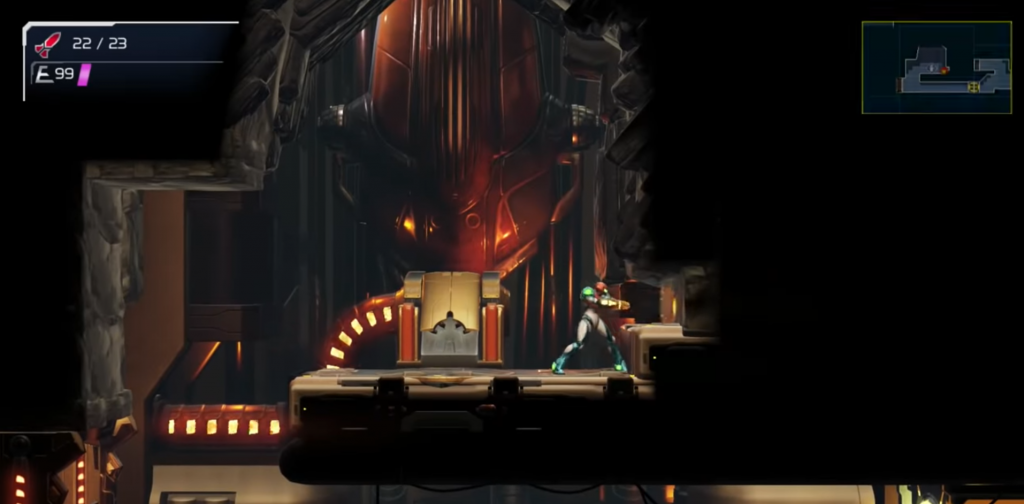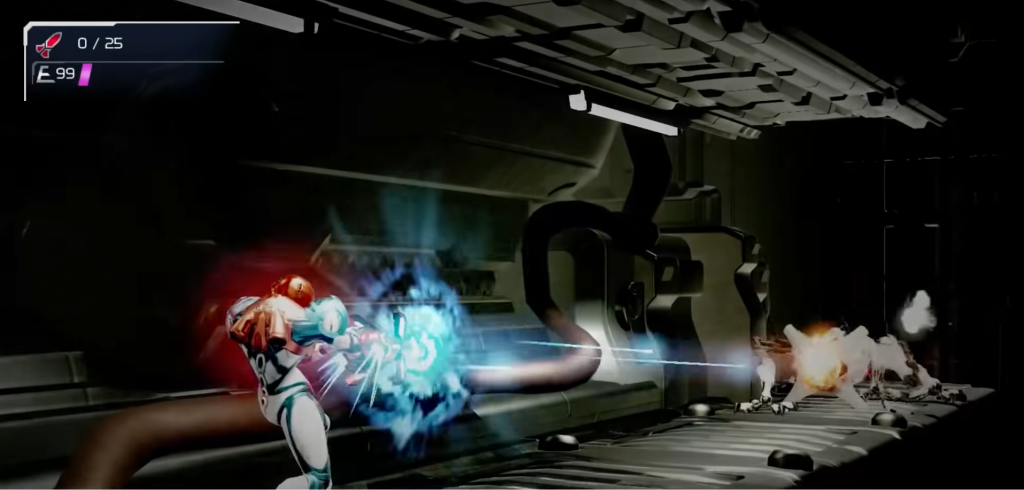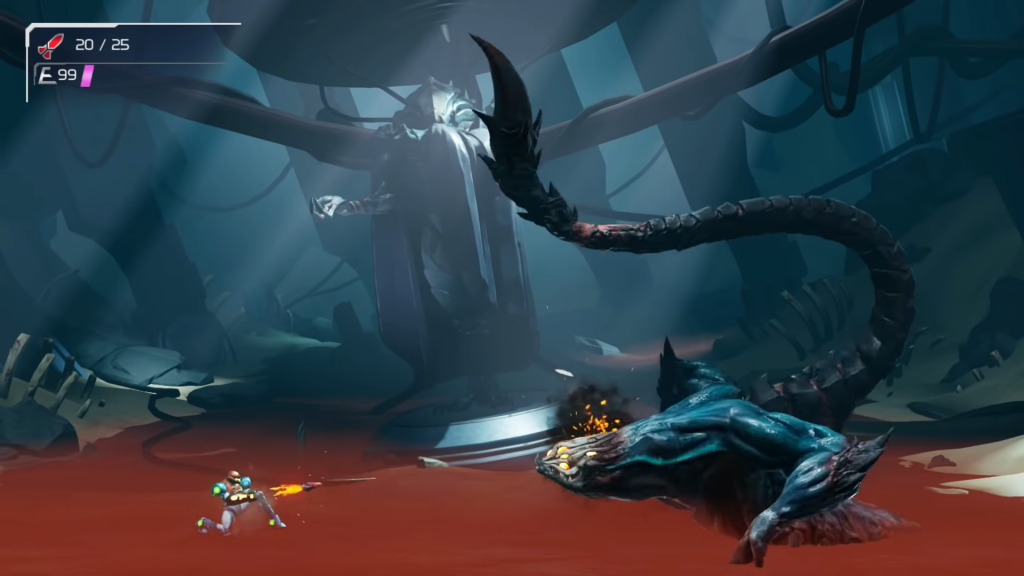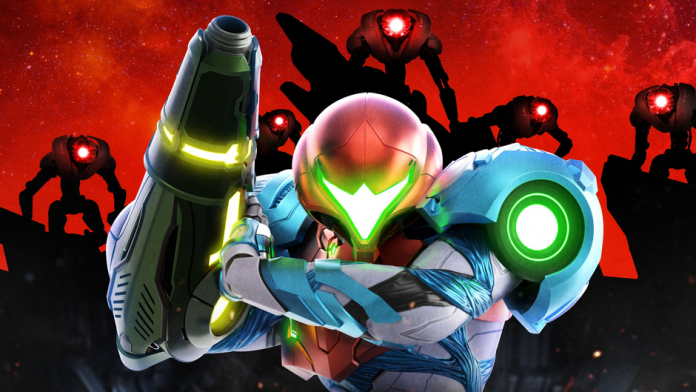19 years after Metroid Fusion, and in a world now brimming with Metroidvanias, Metroid Dread provides a thrilling end to the Samus Aran saga.
It’s been a long time since Metroid fans have been able to explore hostile worlds and remote space stations in the 2D perspective. And yet, upon booting up Metroid Dread—the first new 2D Metroid game in over 19 years—all that time seems to melt under the warm glow of nostalgia. With Nintendo’s recent misfires in the 3D Metroid lineage (I’m looking at you Other M), a return to the series roots is just what the doctor ordered. Players are once again out of the suit, but very much back in the game.
Metroid Dread’s opening cinematic recaps the events which unfolded two decades ago, bringing you up to speed with the Metroids, X Parasites, and the exploits of Samus Aran. It seems Samus’s job protecting the galaxy is far from over when a mysterious transmission showing an X Parasite, her old foes from Metroid Fusion that she supposedly wiped out, is received from the Planet ZDR. After going to investigate, Samus is promptly ambushed by an ominous Chozo, the first time we have seen a living, breathing Chozo in the entire franchise. Surviving, but left with ‘physical amnesia’, the opening moments conveniently wipe the slate clean for you to spend the next nine hours regaining much of the same power ups from previous Metroid games. Despite being a fairly safe retreading of the now-ubiquitous Metroidvania formula this is far more rewarding experience than it sounds, and for one simple reason. Metroid Dread is by far the most challenging Metroid game to date.
Lost In Space—Dreadfully Good Fun
Planet ZDR is home to a diverse ecosystem where all creatures, big and small, are equally capable of delivering a game over screen. Even the shark-like Ply—a fairly common and moderately threatening enemy—has the potential to chip down your health considerably if you grow complacent in your exploration. Samus’s power beam dispatches most of these smaller enemies, however, but once you re-enter a room they will be waiting for you once again.
The decision to allow enemies to respawn in rooms once you re-enter them had the potential to slow down exploration, but thankfully the inclusion of parrying—here incorporated from the 3D Metroid games—makes handling most enemies a breeze so long as you get your timings right. When an enemy is about to attack, their body will flash and present you with an opportunity to counter. If you do so successfully, not only will you parry their attack but Samus will leap forward and aim her blaster ready for you to dispatch many enemies in a single blast. There’s a pleasant momentum to the whole procedure which prevents clearing out the same rooms again and again from ever growing stale.

Which is all well and good because you’re going to get lost in this map—a lot. One of the biggest shortfalls of Metroid Dread is how muddled the map can feel at times. Far from feeling intricately designed, the world becomes a labyrinth with little logic behind where you should go from moment to moment. In my nine-hour playthrough, I lost track of the amount of times I hit a roadblock, only for the solution to be shooting a discreet patch of wall to reveal a secret pathway. The experience was tedious for the first few instances and outright frustrating from then on out.
Sure, there might be an extra energy pack around the next corner to power up Samus, but unless you’re struggling—why do you really care?
The problem is compounded largely by ZDR itself. For all its stunning visuals, it is devoid non-hostile life, save for the occasional creautre that bounds away in the background upon Samus’s entry into a room. For the most part you’re navigating empty corridors, and encountering the same predictable enemies. Your AI, Adam, is a welcome addition and massively improved from his overbearing orders and limits in Other M. Despite his guidance with a calming synthetic voice that ironically adding life to this planet, his inclusion is limited to save rooms which doesn’t do much to make ZDR feel any less ghostly. Beyond progressing the story, there’s no compelling reason to explore, at least not in the same way as with games like Hollow Knight or Ori which created such rich, engrossing 2D worlds. Sure, there might be an extra energy pack around the next corner to power up Samus, but unless you’re struggling—why do you really care?
Prepare For A Serious Challenge
But that’s not to say this game is without struggle. The name perhaps refers to the feeling evoked by encountering the E.M.M.I.s—near indestructible robots which will pursue Samus in certain sections of the map. These enemies are terrifying both in their cold, insect like movements and the cavernous soundtrack which accompanies their presence. When an E.M.M.I. catches you the chances of survival are practically zero, with the only thing standing between you and a game over screen is a precisely timed parry. I can’t have pulled off this parry more than five times during my own parry-heavy playthrough. But when I did pull it off, I found myself with a second wind and a rush of adrenaline, which always made the subsequent race to the exit a wildly exciting one.

The only way to take out an E.M.M.I is by reaching a Central Unit. These mini-bosses, reminiscent of the series’ Mother Brain, grant Samus a temporary Omega Cannon. The only weapon capable of destroying the E.M.M.I.s, the Omega Cannon has a considerable charge time during which Samus must remain stationary. This means that despite being temporarily powered up, Samus is still vulnerable to the pursuing E.M.M.I. as you must strategically find the safest place to charge up your Omega Cannon. Interestingly, it is in these brief moments that Metroid Dread feels like a horror game, as an E.M.M.I. slowly crawls towards you, testing your nerves, and slowly making you question whether or not you’ve given yourself enough space to pull off this shot. You’ll never feel like you’ve got enough time, and yet somehow you always do.

Metroid Dread also boasts a lot more conventional bosses besides the E.M.M.I., ranging from the predictably oversized and grotesque to smaller and more nimble bosses which test your reflexes. Not to be beaten on your first try, these bosses have intricate move cycles which must be learnt in order to defeat them. There’s a Dark Souls-quality to the way you must first decipher the boss’s move patterns and form a plan of attack to take advantage of their weaknesses. Sure, a lot of these bosses have large glowing weak points, and three distinct phases, but the question of how you’re going to damage the weak spot is frequently a lot more challenging. And that sentiment rings true for Metroid Dread as a whole. It doesn’t mess with the formula we’ve all come to love, it just executes it exceptionally well.
Metroid Dread is a thrilling end to the Samus Aran saga. With a compelling story and sharp gameplay, this is the best Metroid has been in a long while. Dread fails to provide a compelling reason to explore the Planet ZDR, but you’ll have a fantastic time trying to escape.
The Verdict: 7/10
Words by Jake Abatan
Support The Indiependent
We’re trying to raise £200 a month to help cover our operational costs. This includes our ‘Writer of the Month’ awards, where we recognise the amazing work produced by our contributor team. If you’ve enjoyed reading our site, we’d really appreciate it if you could donate to The Indiependent. Whether you can give £1 or £10, you’d be making a huge difference to our small team.
